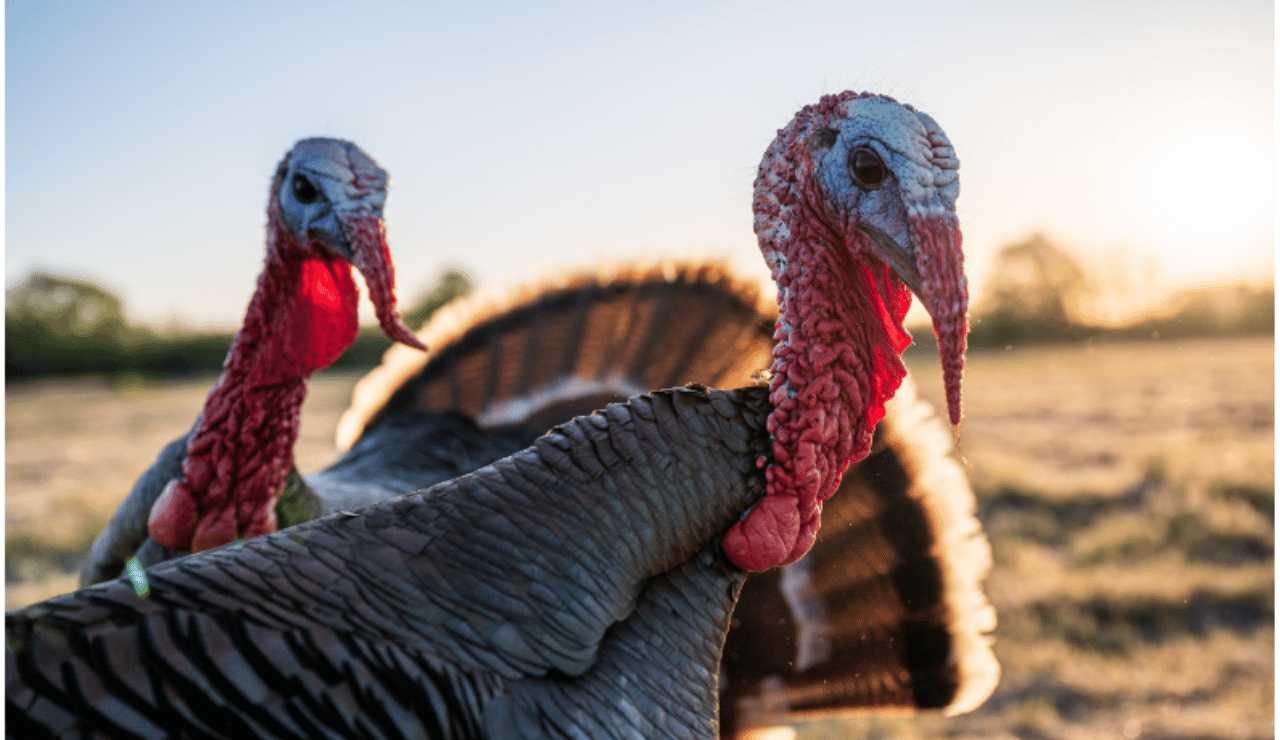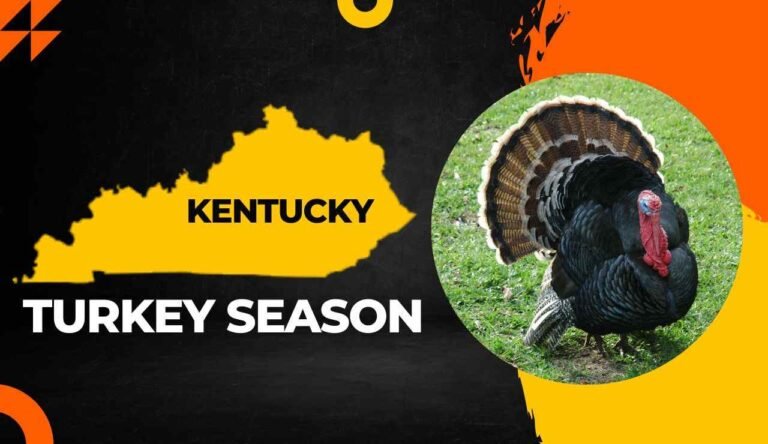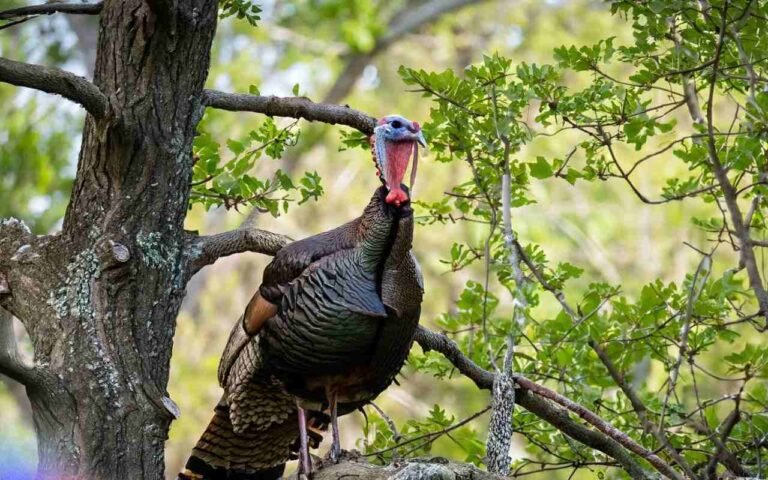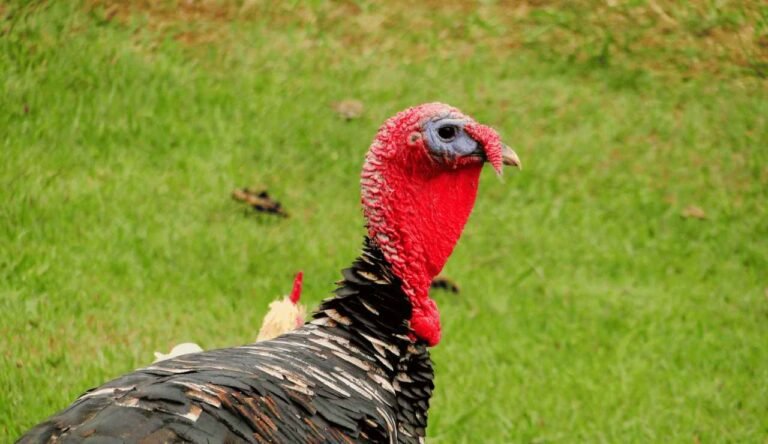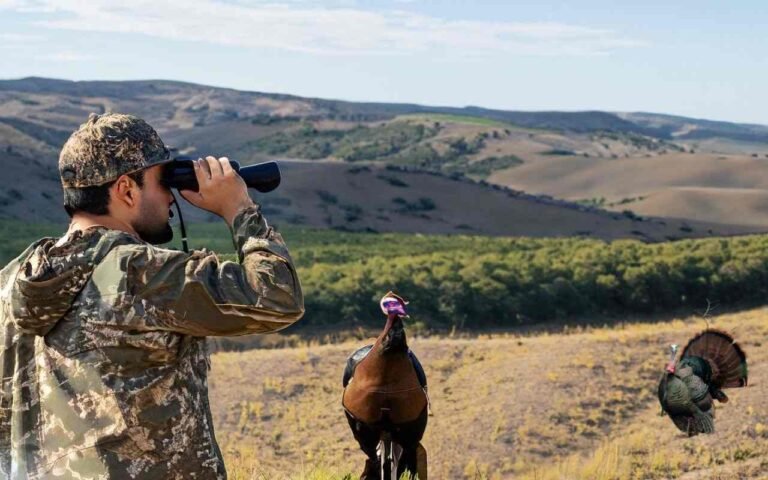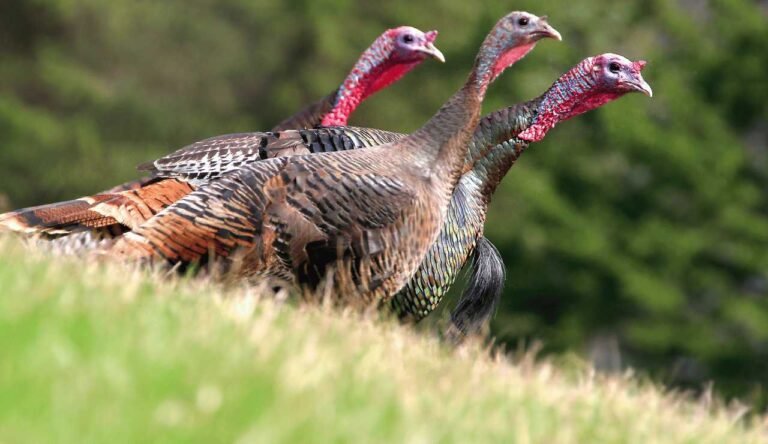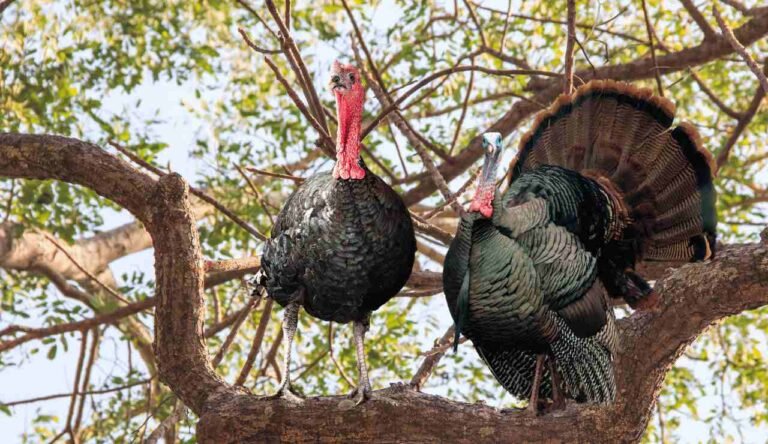How to Hunt Turkey Like a Champ? [The Ultimate Guide To Turkey Hunting in Wild]
Turkey hunting is a popular springtime outdoor activity in North America that requires specific skills due to the keen senses of wild turkeys. Turkey hunting is unlike many other types of hunting in that it calls for particular abilities and strategies. This is because wild turkeys are difficult to hunt due to their excellent senses of sight and hearing. Turkey hunting might be difficult, but it can also be incredibly gratifying and a chance to spend time in nature.
Knowing how to hunt a turkey is essential for a secure and moral experience, regardless of your level of hunting expertise. However, it also demands specific skills and strategies to bag a bird effectively. In this blog article, we’ll go through the crucial measures to help you prepare for a turkey hunt, from picking the correct equipment and scouting spots to calling strategies and shot placement.
Overview of Wild Turkeys: (Characteristics, Habitat, and Species Difference)
American wild turkeys are intriguing. Pheasants, grouse, and other game birds are Galliformes. Wild turkeys exhibit these traits:
Size and appearance: The male wild turkey, or tom, is bigger than the female, or hen. Males are 11–24 pounds and 49 inches long. Females weigh 8 pounds and are much smaller. Both sexes have bald, reddish heads and long, fan-shaped tails for show. Female turkeys have brown or gray feathers, while males have copper to greenish-gold iridescent feathers.
Diet: Wild turkeys are opportunistic foragers that consume insects, seeds, nuts, berries, snails, and salamanders. They love acorns, an essential autumn and winter food source.
Habitat and range: Wild turkeys inhabit woods, meadows, and wetlands. The Rio Grande wild turkey is native to Texas, Oklahoma, and portions of Mexico. Canada to Mexico has them.
Behavior: Wild turkeys are secretive and more active during the day [8]. They sleep in trees and feed on the ground. Males show for females by puffing out their feathers, strutting, and gobbling during spring breeding.
Common Types of Turkeys and Their Characteristics
There are several species of wild turkey, each with its range and characteristics:
| Species | Characteristics |
|---|---|
| Eastern | The most common wild turkey species in the eastern US and Canada. The biggest of the five subspecies has dark brown feathers. |
| Osceola | Only found in Florida. It has a restricted range and is darker than the eastern wild turkey. |
| Rio Grande | This subspecies lives in the central and western US and Mexico. It prefers drier, open areas and has lighter brown feathers than the eastern wild turkey. |
| Merriam's | From the Rocky Mountains to the Sierra Nevada, this subspecies is found in the western US. Mountainous environment suits its lighter feathers with white tips |
| Gould's | This subspecies is found in Mexico and portions of Arizona and New Mexico. It has a white tail band and is the biggest subspecies. |

Turkey Hunting Gear Checklist
| Item | Purpose |
|---|---|
| Shotgun | To take the shot |
| Turkey Loads | To have adequate firepower |
| Camouflage Clothing | To blend into the surroundings |
| Turkey Vest | To carry calls, ammo, and other accessories |
| Turkey Calls | To attract and communicate with turkeys |
| Hunting Boots | To be comfortable and quiet while walking |
| Binoculars | To spot turkeys from a distance |
| Face Mask | To conceal your face and avoid detection |
| Decoys | To attract turkeys and create a distraction |
| Snacks and Water | To stay energized and hydrated during the hunt |
Key Equipment for Turkey Hunting: Firearms, Gear, and Accessories
To improve your chances of success and protect your safety while out in the field, turkey hunting involves a range of equipment. The following elements are crucial to think about while getting ready for a turkey hunt:
Firearms and Ammunition: The shotgun is one of the essential pieces of gear for turkey hunting. Turkey hunting usually calls for a 12 or 20-gauge shotgun with a modified or full choke. Regarding ammunition, loads explicitly designed for turkeys with #4, #5, or #6 shots are often utilized because of their effective range and knockout force.
Clothing and Protective Gear: To evade a turkey’s keen eyes, camouflage clothing is essential. To blend with their environment, many hunters use textured clothing or suits with leaves on them. For grip and stability, comfortable shoes and rubber knee boots with ankle support are also essential while negotiating the terrain. A safety vest should also be worn to increase visibility to other hunters.
Calls & Decoys: There are many different kinds of turkey calls, including slate calls, box calls, and mouth calls. It’s vital to use calls that closely resemble the distinct sounds of a turkey. A turkey may be lured in using decoys, especially hen and tom decoys.
Other Useful Gear: A catchall bag helps keep tiny goods like bandages, parachute cords, tweezers, dental floss, Q-tips, Visine, safety pins, aspirin, Rolaids, a pencil, and wet wipes. Keeping calls, ammo, and other necessities in a vest designed for turkey hunting might be helpful. Finally, a ground hunting blind may provide cover and raise your success rate.
It is crucial to examine local laws and regulations before leaving the house to guarantee a legal and safe hunt, like with other hunting activities.
Turkey Calls and When to Use Them
| Call Type | When to Use it | Purpose |
|---|---|---|
| Locator | Early morning | To locate turkeys before daylight |
| Yelp | During the day | To locate other turkeys and communicate |
| Cluck | All day | To get turkeys to look in your direction |
| Purrs | Late morning to midday | To reassure turkeys that everything is safe |
| Cutting | Mid-morning to early afternoon | To imitate excited hens and provoke a response from gobblers |
| Gobble | Late afternoon | To locate other gobblers and announce your presence |
Preparing for a Successful Hunt: (Regulations, Locations, and Conditions)
To improve your chances of success and protect your safety while out in the field, turkey hunting involves a range of equipment. The following elements are crucial to think about while getting ready for a turkey hunt:
Firearms and Ammunition: The shotgun is one of the essential pieces of gear for turkey hunting. Turkey hunting usually calls for a 12 or 20-gauge shotgun with a modified or full choke. Regarding ammunition, loads explicitly designed for turkeys with #4, #5, or #6 shots are often utilized because of their effective range and knockout force.
Clothing and Protective Gear: To evade a turkey’s keen eyes, camouflage clothing is essential. To blend with their environment, many hunters use textured clothing or suits with leaves on them. For grip and stability, comfortable shoes and rubber knee boots with ankle support are also essential while negotiating the terrain. A safety vest should also be worn to increase visibility to other hunters.
Calls & Decoys: There are many different kinds of turkey calls, including slate calls, box calls, and mouth calls. It’s vital to use calls that closely resemble the distinct sounds of a turkey. A turkey may be lured in using decoys, especially hen and tom decoys.
Other Useful Gear: A catchall bag helps keep tiny goods like bandages, parachute cords, tweezers, dental floss, Q-tips, Visine, safety pins, aspirin, Rolaids, a pencil, and wet wipes. Keeping calls, ammo, and other necessities in a vest designed for turkey hunting might be helpful. Finally, a ground hunting blind may provide cover and raise your success rate.
It is crucial to examine local laws and regulations before leaving the house to guarantee a legal and safe hunt, like with other hunting activities.
Mastering Turkey Hunting Techniques: (Behavior, Calling, Blinds, and Ambushing)
- Successful turkey hunting depends on having a solid understanding of turkey behavior and vocalizations.
- Wild turkeys have at least 29 distinct vocalizations, with the gobble serving as the primary male vocalization during the spring breeding season.
- Hunters may replicate calls to entice birds to their area by using their understanding of turkey vocalizations.
- Techniques for calling and decoying turkeys are crucial turkey hunting tactics.
- Early in the morning, aggressive calling may be helpful for roosted toms, while more subtle methods can be utilized to mimic the sounds of nearby turkeys.
- You may also employ decoys to entice cautious birds, including hen or jake decoys.
- For successful turkey hunting, it’s also critical to set up efficient blinds.
- Choosing a spot with sufficient cover and visibility is crucial while staying away from places where other hunters could congregate.
- To prevent frightening turkeys, blinds should mix well with their environment. Natural materials may be utilized to achieve this.
- Hunting for turkeys may also benefit from ambushes and stalking.
- Patience is often required for success, and it is advisable to utilize the terrain and cover to remain concealed when approaching the birds.
Turkey Food Sources
| Food Source | Description |
|---|---|
| Acorns | A favorite fall food source for turkeys, they provide high fat and protein content for the birds. |
| Clover | Rich in protein and easy for turkeys to digest, making it a popular food source in the spring. |
| Grasshoppers | A high-protein food source that is readily available in the summer. |
| Seeds and Berries | Provide an important food source in the fall, when turkeys need to put on weight for the winter. |
Scouting for turkeys
| Scout for turkeys by | Benefits of this approach |
|---|---|
| Noting the location where you saw the turkey | Returning to areas of previous success can be reliable |
| Listening for turkey calls and identifying the species | Helps you choose the right hunting gear and tactics |
| Using locator calls and trying to reach the turkey's destination before it arrives | Increases your chances of success |
| Paying attention to turkey sign (tracks, droppings, scratching) | Identifies areas where turkeys are active and good for hunting |
| Understanding what turkeys are eating | Helps identify good areas to scout, especially for spring when turkeys focus on greening fields and plants |
| Getting permission to access private land early | Saves time and provides valuable information from landowners about turkeys on the property |
Turkey Hunting Ethics and Safety: (Firearm Handling, Land Respect, Harvesting, and Conservation)
- When turkey hunting, it is essential to put ethics and safety first. One of the most critical parts of successful turkey hunting is the safe and proper handling of firearms.
- Firearms should only be loaded in the field or on the range and emptied before entering a car, tent, or house.
- Ammunition and firearms should be safely kept in different areas to avoid unwanted access.
- For ethical and safe turkey hunting, respecting the borders between private and public lands is crucial.
- Before hunting on private property, hunters should have the landowner’s consent. When hunting on public territory, hunters must abide by any posted signs and rules.
- Also crucial is showing respect and courtesy to non-hunters, landowners, and fellow hunters.
- It is crucial to harvest and handle turkeys according to legal requirements.
- Aiming for the proper shot placement will provide a speedy, painless death that respects the animal and enhances the meat’s quality.
- To prevent firing at other hunters or non-target animals while calling turkeys, hunters should recognize the target from head to tail.
- Respecting the ecosystem and preventing harm to the surrounding animals or plants is crucial.
- All hunters must safeguard and maintain animal habitats for future generations.
- It’s crucial to abide by all hunting laws and take good care of the land.
- By giving to conservation groups, helping with habitat restoration initiatives, and using moral hunting techniques, hunters may assist efforts to save animals.
Conclusion
Learning from a productive turkey hunt ensures that future hunts are successful and ethical. It stresses the need to appreciate nature and respect the environment and animals while adopting ethical hunting methods, such as avoiding hunting during nesting season and respecting habitats. It also highlights the importance of promoting outdoor recreation while being cautious of noise levels and preserving the environment by packing out the rubbish. Ultimately, ethical and practical turkey hunting requires responsible outdoor recreation and respect for species and their environments to guarantee future generations can enjoy the natural beauty of the outdoors while having a successful hunt.
Frequently Asked Questions
What equipment do I need for turkey hunting?
You may wonder what supplies you’ll need if you’ve never gone turkey hunting. The following list of necessary tools will help you get started and have a good hunt:
• A shotgun or other firearm (rifle or bow)
• Ammunition designed for turkey hunting
• Turkey calls (box calls, slate calls, mouth calls, etc.)
• Decoys (hen, Jake, and Tom decoys)
• Hunting vest with many pockets and compartments
• Appropriate clothing (camouflage recommended)
• Comfortable boots with good traction
• Water and snacks for hydration and energy
• Range finder to determine the distance to the target
• Hunting license and necessary permits/documentation
What are some successful tactics for turkey hunting?
To hunt turkeys effectively, exploring the region ahead is essential to learn about their behavior and movement patterns. Turkeys may also be attracted by using a decoy, and the correct calls, such as a slate call, can produce realistic-sounding noises. The ability of turkey guns to perform well may be increased by employing the correct tools, like red dot sights and TSS loads. Patience is the key to success, particularly during late-season hunts. Staking a jake or strutting gobbler decoy may be a successful setup during early-season hunts. While hunting, it’s crucial to adhere to all local hunting laws and safety precautions.
How do I locate turkeys in the wild?
Hunters often use techniques including examining the landscape, listening for gobbling noises, scouting for indications of activity, and employing ground blinds to set up an ambush position to find wild turkeys. To approach within firing distance, it’s crucial to manoeuvre stealthily while using cover and terrain. It is not recommended to feed wild turkeys since it may lead to confrontations with people and change their standard behavioural patterns. It takes a mix of observation, perseverance, and understanding of their environment and behavior to locate turkeys successfully.
What is the best time of day to hunt turkeys?
It depends on several variables, including the weather, the mating season, and bird behavior, when it is ideal for hunting turkeys. Some experts favor hunting in the late seasons. The last two to three hours of daylight saw a considerable rise in bird activity, making the evening shift a fantastic time to go turkey hunting. However, the most significant time to go turkey hunting is any chance for legal hunting. A tom may be harvested by scouting for roosts, feeding locations, transit paths, and strutting sites.
What is some safety advice for turkey hunting?
Safety should always come first while turkey hunting. Hunting shotguns should be handled carefully and unloaded before entering a car or building, and hunters should wear hunter-orange attire and use caution while deploying decoys and calling turkeys. It’s crucial to avoid donning red, white, or blue clothes underneath camouflage, use the right ammo, be sure of your target before firing, and hide with a ground blind. Above all, hunters should exercise patience and refrain from firing off bullets or making snap judgments. Hunting for turkeys may be safe and pleasurable if these essential safeguards are taken.
How can I effectively call turkeys?
Hunters should use a variety of noises, such as owl hooters, mouth calls, and box calls, to successfully call turkeys. It’s crucial to use the proper call for the noise the turkey is making and to avoid over-calling. The box call howl is the most straightforward and successful cry for novices, while diaphragm calls let hunters use their hands-free and sound more natural. Patience is essential, and calling less often and with quieter tones may be more successful in luring a gobbler. A hunter’s odds of successfully harvesting a turkey may be significantly increased by constantly practicing and mastering several tactics.
What should I do if I spot a turkey while scouting?
Note the spot where you spotted the turkey, listen for turkey calls, watch for turkey signs, and learn what turkeys are eating to improve your chances of success during the future hunting season. Finding regions where turkeys are active, carrying a variety of locator sounds, and scouting by ear may all be effective strategies. Additionally, obtaining early permission to enter private property might help you save time and get proper knowledge about the turkeys on the site from the proprietors. You may improve your chances of having a productive turkey hunt by paying attention to these suggestions.
